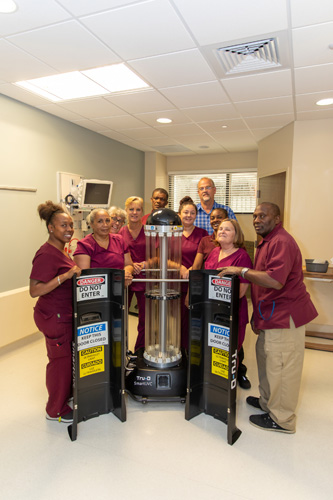
If you’re not at least a little concerned whenever you check into a hospital or any other healthcare facility, maybe you don’t know enough about HAIs (Healthcare Associated Infections).
Ralph Taylor, who is chief operating officer, chief nursing officer and interim president at Steward Health Care’s Sebastian River Medical Center certainly does, and maybe that’s why he has turned to a Star Wars-like robotic device for some extra help in controlling infections.
The Tru-D Ultra-Violet-C device uses low-pressure mercury gas bulbs that emit a strong, narrow band of the UV-C light spectrum that kills bacteria, spores and viruses. It is moved from room to room to finalize the cleaning and disinfection process after a patient leaves and before a new patient comes in.
The U.S. Office of Disease Prevention and Health Promotion says “HAIs are infections people get while they are receiving healthcare for another condition. HAIs can happen in any healthcare facility, including hospitals, ambulatory surgical centers, end-stage renal disease facilities and long-term care facilities.”
The main causes? Bacteria, spores and viruses from sick patients and the environment that tend to linger in hospital settings, infecting additional patients.
“HAIs,” the Office of Disease Prevention continues, “are a significant cause of illness and death. They can have devastating emotional, financial and medical consequences. At any given time, about 1 in 25 in-patients have an infection related to hospital care. These infections lead to the loss of tens of thousands of lives and cost the U.S. healthcare system billions of dollars each year.”
The National Institutes of Health is equally blunt when it says “HAIs are infections that patients contract while in the hospital that were neither present nor developing at the time of admission,” and estimates are that as many as 10 percent of adults with even short-term hospitalizations will develop an HAI.
“In a hospital setting,” Taylor says, “we need to ensure that we’re the cleanest place in the community. We have a very strong team of EVS, or Environmental Services personnel, that do a fantastic job of cleaning. In fact they have one of the hardest jobs in the hospital,” and the Tru-D device will in no way replace the environmental services teams.
Instead it will be a high-tech adjunct that automatically measures the size of the room (including patient rooms, operating rooms or any other room in the hospital) and uses its ultraviolet light to disrupt the DNA of any unseen pathogens that remain after the primary cleaning process.
That DNA disruption prevents them from reproducing and kills them.
Taylor says this newly arrived Tru-D robot is already in use at SRMC.
“The cleaning crew will go in and they’ll clean the room, depending on which type of bacteria may be present from the patient history and/or the active disease. After it’s completely cleaned we’ll push the robot in and that’s the final step before we make the room back up for the next patient. We also do the ORs and endoscopy rooms every single night.”
That’s especially important insofar as a particularly noxious bacterium called “Clostridioides difficile” (C. diff) is often found in an endoscopy setting as well as in patient rooms.
C. diff can cause diarrhea and an inflammation of the colon known as colitis and in this area’s demographic, it can be a killer.
As the Mayo Clinic explains, illness from C. diff most commonly affects older adults in hospitals or in long-term care facilities. Moreover, says the Rochester, Minnesota, institution, “one in every 11 people over age 65 with a healthcare-associated C. diff infection will die from it.”
Even worse, the folks at Mayo point out, “in recent years, C. diff infections have become more frequent, severe and difficult to treat while recurrent C. diff infections also are on the rise.”
Changing that trend is a lot to ask of any new device – even one with a Star Wars nickname.
Taylor calls it “R2-D2, but taller. It’s as tall as C-3PO but it’s as round as R2-D2.”
The big question is – whatever you call this Tru-D device – will it work?
Taylor points to a recent study by the Duke Center for Antimicrobial Stewardship and Infection Prevention that showed the “disinfection strategies” utilized by the Tru-D unit reduced the risk of acquisition and infection of four major superbugs – including C. diff – by 30 percent.
Maybe that’s not a grand slam but it’s certainly a big step in the right direction.
Taylor says he and his staff will constantly monitor HAI rates at SRMC now that the Tru-D device is in daily use to determine its effectiveness here.
“It takes a while,” Taylor explains, “to see a trend. We’ve only had it for three weeks. So we’ll start to see [hard] evidence of its efficiency probably in about 90 to 100 days.”



